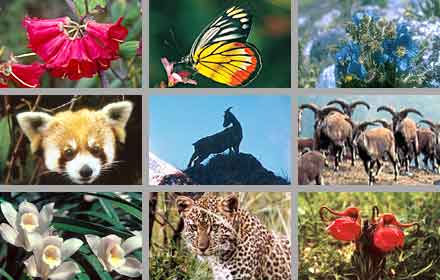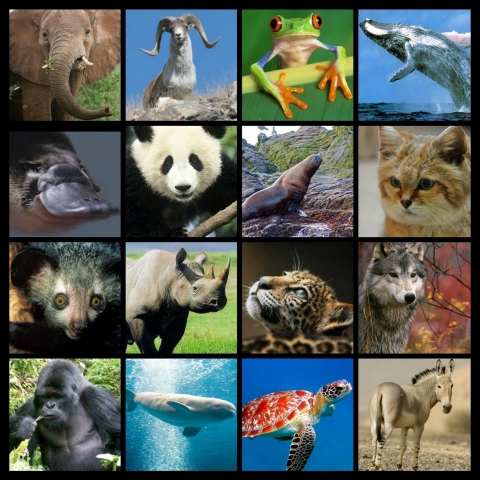Large varieties of plants and animals exist on earth.
They are essential for the wellbeing and survival of mankind.
DEFORESTAION AND ITS CAUSE
The clearing of forests and using the land for various purposes is termed
as deforestation.
It is responsible for survival threat to many living organisms.

Causes
-
Procuring land for cultivation
-
Agriculture related purposes
-
Fuel requirement from wood
-
Setting up industries
-
Making furniture
-
Natural causes like forest fires, droughts, etc.
CONSEQUENCES OF DEFORESTATION
-
Increase the temperature and pollution level.
-
Increase the level of carbon dioxide.
-
Decrease in the ground water level.
-
Decrease in rainfall and fertility of soil.
-
Increase in natural calamities like floods, droughts, etc.
-
Decrease in the water holding capacity and water infiltration rate of
soil.
-
Global warming
- decrease in number of trees that will lead to increase in carbon
dioxide level in the atmosphere. The carbon dioxide gas traps the heat
rays reflected from earth’s surface and this will result in increase in
temperature on earth and it will disturb the water cycle too and may
reduce rainfall. This could cause droughts.
-
Deforestation is also responsible for the change in the soil properties.
Lesser number of trees will result into more soil erosion. The removal of
top layer of soil will result into hard rocky layer which is less fertile
and humus.
-
Gradually, the fertile land will be converted into deserts. Such a
process is known as desertification.
COSERVATION OF FOREST AND WILDLIFE
To prevent deforestation and for the conservation of forests and wildlife,
the government lays down many rules and regulation.
Wildlife sanctuaries, national parks and biosphere reserves have been
marked as protected areas where activities like plantation, cultivation,
grazing, hunting, poaching, etc. are prohibited.
Sanctuary -
These are the places where animals and their habitants are safe from any
external disturbances with very limited human activities.
Examples are Corbett national park in Uttarakhand, Ranthambore National
Park in Rajasthan, etc.
National Park -
Areas reserved for animals where they can use their habitats and natural
resources freely. Examples are Bandipur National Park in Karnataka,
Keoladeo Ghana National Park in Rajasthan, etc.
Biosphere Reserve
- These are the places for conservation of wild life, animals, plants,
traditional life of tribes, etc.These are the areas meant for the
conservation of bio diversity.
Bio-diversity
- It refers to the variety of organisms living on the earth, their
inter-relationships and their relationships with the environment.
Example-The Pachmarhi Biosphere Reserve consists of one national park named
as Satpura and two wildlife sanctuaries named as Bori and Pachmarhi.
FLORA AND FAUNA
The plants and animals found in a particular area are termed as the flora
and fauna of that area.
Flora-
The plants of a particular area are termed as its flora.
Examples of flora include coral, teak, mango, neem, sunflower, etc.
Fauna-
The animals of a particular region are termed as its fauna.
Examples of fauna include deer, lion, parrot, eagle, ant, goldfish, etc.

EPIDEMIC SPECIES
those species of plants and animals which are exclusively found in a
particular area and not found anywhere else.
Any animal or plant could be endemic to an area, a state or a country.
If any destruction takes place in their habitats, then it could affect
their population and could also endanger the entire species existence.
Example- tree like sal, wild mango, etc. and animals like bison, Indian
giant squirrel, etc. which are found only in Pachmarhi Biosphere Reserve.
WILD LIFE SANCTUARY
Areas reserved for the protection and suitable living conditions to wild
animals.
-
Activities like hunting; poaching, capturing, etc. of animals is
prohibited in these sanctuaries.
-
Sanctuaries have given protection to many endangered species like black
buck, white eyed buck, elephant, golden cat, pink headed duck, marsh
crocodile, rhinoceros, etc.
NATIONAL PARK
-
These reserves are large and diverse that provides protection to entire
ecosystem.
-
They preserve plants, animals, lands and historic objects etc. of that
particular area.
-
Ex-Satpura National Park: It is the first Reserve
Forest of India. The finest Indian teak is found in this forest.
Moreover, rock shelters are also found in this park.
-
An initiative "Project Tiger" was launched by the
government to protect tigers in this place. The main aim behind this
project was to protect and increase the tiger population of the
country.
In earlier times, animals like lions, elephants, wild buffaloes, etc.
were also found in this reserve forest.
Endangered species
- Those animals whose numbers are gradually decreasing and might get
extinct soon are known as endangered animals.
Examples of some endangered animals are snow leopard, whooping crane, Giant
Panda, etc.

Ecosystem
-
System that comprises of all the plants, animals and micro-organisms
living in a particular area along with non-living things like air, water,
soil, etc.
-
Equal importance of each and every organism whether it may be snakes,
frogs, lizards, bats, etc. for proper functioning of an ecosystem.
RED DATA BOOK
-
It is a source book which has list of all the endangered animals and
plants.
-
Different books for plants, animals and other species.
MIGRATION
-
Seasonal movement of animals, birds, etc. from one place to another in
search for better breeding place, climate, food, etc.
-
There are many birds that migrate far away due to climatic changes mainly
for breeding purpose. They need suitable climate for rearing their young
ones.
RECYCLING OF PAPER
One of the reasons for deforestation is the manufacturing of the papers.
Lots of harmful chemicals are utilized in manufacturing process of papers. It takes 17 full grown trees to make one tonne of paper.
.
REFORESTATION
reforestation is restocking of the destroyed forests by planting new trees.
-
New plants of same species which were present before should be planted.
-
Plant the same or more number of trees as we cut.
-
Natural growth of trees taking place at deforestation site if left
undisturbed. No human role is needed is known as Natural reforestation.
-
India has the forest Act which aimed at preservation and conservation of
natural forests.